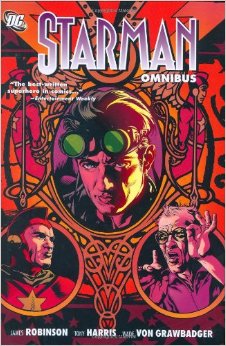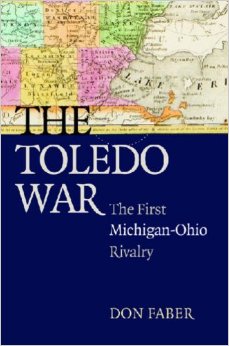 The Starman Omnibus Vol. 1 – I heard that this was a series not to be missed so I decided to pick it up when I was at the library. Boy, were they right! From the first pages of the opening comic, it’s obvious that what James Robinson is doing is telling an epic through several different characters as stories, always aiming for something bigger. With appearances by the different eras of superheroes and other Starmans (Starmen?), it creates a world that not only conceivably realistic (as far as a comic with a cosmic rod can be realistic), but more importantly, believable. This is a tale for those who want to think, who aren’t always interested in the flash-bang world that some comics present. This is a comic for those who are interested in a hero who is good because he is a nice person. I cannot wait for the second volume. Everyone should read this now.
The Starman Omnibus Vol. 1 – I heard that this was a series not to be missed so I decided to pick it up when I was at the library. Boy, were they right! From the first pages of the opening comic, it’s obvious that what James Robinson is doing is telling an epic through several different characters as stories, always aiming for something bigger. With appearances by the different eras of superheroes and other Starmans (Starmen?), it creates a world that not only conceivably realistic (as far as a comic with a cosmic rod can be realistic), but more importantly, believable. This is a tale for those who want to think, who aren’t always interested in the flash-bang world that some comics present. This is a comic for those who are interested in a hero who is good because he is a nice person. I cannot wait for the second volume. Everyone should read this now.
 DC Universe: The Stories of Alan Moore – A great assortment of Alan Moore’s work, including “The Killing Joke,” “For The Man Who Has Everything,” and “Whatever Happened to the Man of Tomorrow?”. Looking at this collection, it’s easier to see where some his later works would spring from and maybe why he left DC (in my opinion, Moore appears to want to tell his darkly-tinged stories the way he wants to tell them, and playing with other people’s established characters does not allow full control). Pick it up for some food for thought.
DC Universe: The Stories of Alan Moore – A great assortment of Alan Moore’s work, including “The Killing Joke,” “For The Man Who Has Everything,” and “Whatever Happened to the Man of Tomorrow?”. Looking at this collection, it’s easier to see where some his later works would spring from and maybe why he left DC (in my opinion, Moore appears to want to tell his darkly-tinged stories the way he wants to tell them, and playing with other people’s established characters does not allow full control). Pick it up for some food for thought.
 Soccernomics – Soccernomics does the near impossible: it makes economics and statistics interesting to the common soccer fan, and does it without dumbing down the material. Written by Simon Kuper and Stefan Szymanski, this book explains the beautiful game with beautiful numbers. Why doesn’t England win? Is Brazil an anomaly? Do more people kill themselves after a terrible match? All these questions and more are answered in this text. More than Freakonomics for the sports set, this is an eloquent study of mathematics on the soccer pitch. I’d definitely recommend it to any soccer fan who wants to understand the mental workings of the game or any stats fan with an interest in soccer.
Soccernomics – Soccernomics does the near impossible: it makes economics and statistics interesting to the common soccer fan, and does it without dumbing down the material. Written by Simon Kuper and Stefan Szymanski, this book explains the beautiful game with beautiful numbers. Why doesn’t England win? Is Brazil an anomaly? Do more people kill themselves after a terrible match? All these questions and more are answered in this text. More than Freakonomics for the sports set, this is an eloquent study of mathematics on the soccer pitch. I’d definitely recommend it to any soccer fan who wants to understand the mental workings of the game or any stats fan with an interest in soccer.
 The Toledo War: The First Michigan-Ohio Rivalry – There has always been competition between Michigan and Ohio. While in the present day it consists of Wolverines vs. Buckeyes trash talk and a lot of derogatory remarks, the 1830s were a bit more exciting. How? WAR. In 1835, both Ohio and Michigan felt that they had a claim to the Toledo Strip due to the Mitchell map used to create the Northwest Ordinance of 1787. Don Faber does an admirable job of explaining the intricacies of the Toledo War, presenting the buildup towards the war and both sides’ arguments (legal or otherwise) in a coherent, non-partisan manner. Coupled with an epilogue, a timeline of events, and peppered with fun facts throughout (for example, why Michigan residents are referred to as wolverines, when there aren’t any in the state) this slim volume is a valuable book for anyone interested in antebellum America.
The Toledo War: The First Michigan-Ohio Rivalry – There has always been competition between Michigan and Ohio. While in the present day it consists of Wolverines vs. Buckeyes trash talk and a lot of derogatory remarks, the 1830s were a bit more exciting. How? WAR. In 1835, both Ohio and Michigan felt that they had a claim to the Toledo Strip due to the Mitchell map used to create the Northwest Ordinance of 1787. Don Faber does an admirable job of explaining the intricacies of the Toledo War, presenting the buildup towards the war and both sides’ arguments (legal or otherwise) in a coherent, non-partisan manner. Coupled with an epilogue, a timeline of events, and peppered with fun facts throughout (for example, why Michigan residents are referred to as wolverines, when there aren’t any in the state) this slim volume is a valuable book for anyone interested in antebellum America.
 Baseball Fever: Early Baseball in Michigan– Peter Morris does a brilliant job of describing the very early days of baseball in Michigan. Beginning with the foundations of baseball in New York, we quickly slide over to theGreat Lakes State and the multitude of clubs that were created from the late 1850s to the mid 1870s. Some noteworthy gems include the Unknowns of Jackson, the Chief Club of Tecumseh, the Hungry Nine of Birmingham, and more Peninsulars and Wolverines than you could ever imagine. Baseball may have waxed and waned in 19th century Michigan, but it was never forgotten. Well-written and easily read, this book is great for every baseball aficionado.
Baseball Fever: Early Baseball in Michigan– Peter Morris does a brilliant job of describing the very early days of baseball in Michigan. Beginning with the foundations of baseball in New York, we quickly slide over to theGreat Lakes State and the multitude of clubs that were created from the late 1850s to the mid 1870s. Some noteworthy gems include the Unknowns of Jackson, the Chief Club of Tecumseh, the Hungry Nine of Birmingham, and more Peninsulars and Wolverines than you could ever imagine. Baseball may have waxed and waned in 19th century Michigan, but it was never forgotten. Well-written and easily read, this book is great for every baseball aficionado.








































